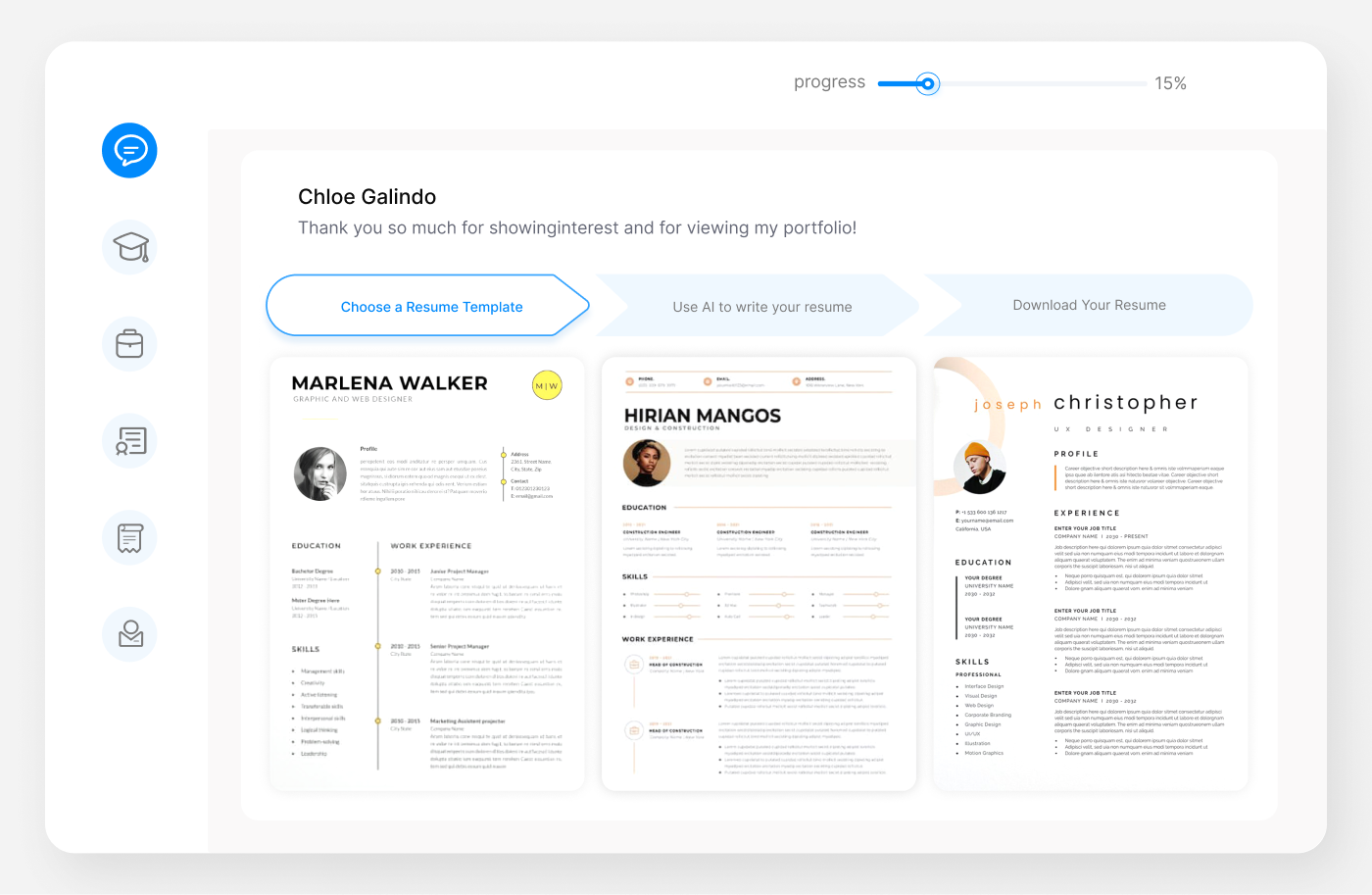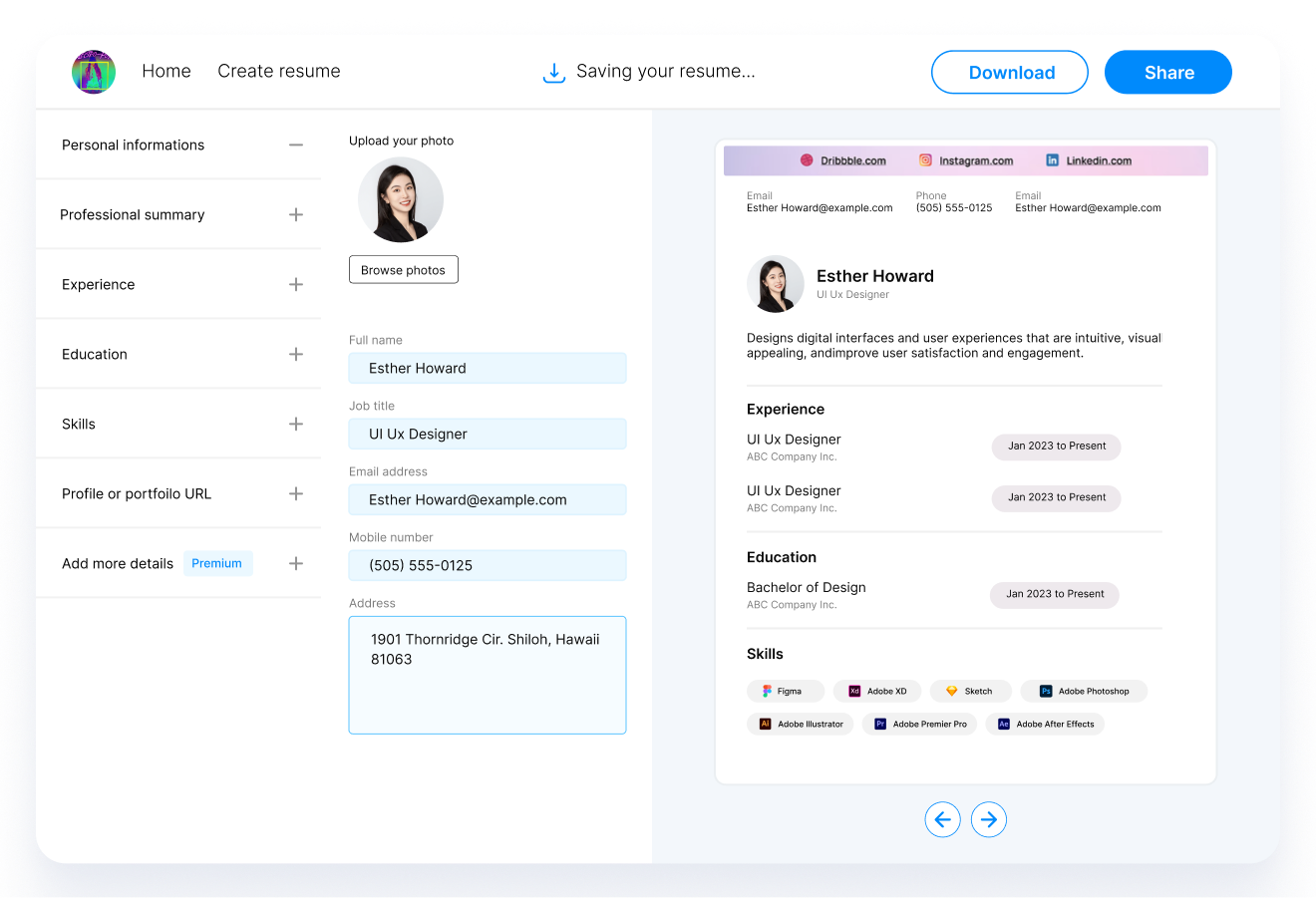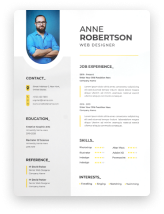In the ever-evolving field of medicine, crafting a resume that stands out is more crucial than ever for doctors seeking to advance their careers. Whether you're a seasoned physician or a recent medical school graduate, understanding how to highlight your skills, experience, and accomplishments is key to catching the eye of top healthcare institutions. This guide offers comprehensive insights into creating a resume that not only showcases your professional expertise but also reflects your commitment to patient care and continuous learning. From structuring your resume to selecting the right experiences to include, we'll provide you with actionable advice to help you navigate the competitive landscape of the healthcare industry and take your career to new heights.

Doctor Resume Example
Dr. Sarah Ahmed, MD
Email: sarah.ahmed.md@example.com | Phone: (555) 123-4567
Address: 123 Medicine Lane, Health City, State, 12345
LinkedIn: linkedin.com/in/sarahahmedmd
Professional Summary:
Board-certified internal medicine physician with over 10 years of experience in hospital and clinical settings. Demonstrated ability to provide high-quality patient care, manage complex cases, and lead cross-functional healthcare teams. Skilled in developing and implementing treatment plans, with a strong focus on preventive care and patient education. Committed to ongoing professional development and staying abreast of the latest medical research.
Work Experience:
Senior Physician, Internal Medicine
General Hospital, Metropolis, State
June 2016 – Present
- Lead a team of 10 healthcare professionals, including nurses and junior doctors, ensuring the delivery of exceptional patient care to over 50 patients daily.
- Initiated a preventive care program that resulted in a 20% reduction in hospital readmissions for chronic disease patients.
- Conducted groundbreaking research on the management of diabetes, which was published in the "Journal of Advanced Medical Research."
- Developed and conducted internal training sessions on the latest treatment protocols, significantly improving treatment outcomes.
Resident Physician, Internal Medicine
University Medical Center, College Town, State
July 2011 – May 2016
- Provided comprehensive care to a diverse patient population, including diagnosing conditions, developing treatment plans, and managing patient follow-up.
- Actively participated in weekly grand rounds, presenting cases and engaging in multidisciplinary discussions to optimize patient care strategies.
- Contributed to the university's medical research projects, focusing on hypertension and its impact on long-term health outcomes.
- Mentored medical students and junior residents, fostering an environment of learning and professional growth.
Education:
Doctor of Medicine (MD)
Prestigious University School of Medicine, City, State
September 2007 – May 2011
Bachelor of Science in Biology
Top-Tier University, City, State
September 2003 – May 2007
Certifications:
- Board Certified in Internal Medicine, American Board of Internal Medicine
- Advanced Cardiovascular Life Support (ACLS)
- Basic Life Support (BLS)
Professional Affiliations:
- American Medical Association (AMA)
- American College of Physicians (ACP)
Skills:
- Patient care and advocacy
- Complex case management
- Team leadership and training
- Medical research and publication
- Preventive care initiatives
Volunteer Experience:
- Volunteer Physician, Free Health Clinic, City, State: Provide free medical care to underserved populations on weekends.
- Medical Mission Trip Coordinator, Global Health Initiative: Lead annual trips to provide medical services in underserved international communities.
Resume Format and Structure
Crafting a resume for a doctor requires a thoughtful approach to format and structure, ensuring that your most relevant qualifications and experiences are easily accessible to hiring managers. Here are key elements to consider:
Choosing the Right Resume Format
There are three main resume formats: chronological, functional, and combination. Each has its advantages, but for doctors, the chronological format is often most effective. This format lists your work experience in reverse chronological order, starting with your most recent position. It allows you to showcase your progressive experience in the medical field, highlighting your achievements and responsibilities in each role.
Essential Sections of a Doctor's Resume
1. Contact Information: Include your full name, phone number, email, and LinkedIn profile. Ensure your email is professional.
2. Professional Summary: A brief overview of your experience, skills, and what you bring to a potential employer. Highlight your medical specialty, years of experience, and key accomplishments.
3. Work Experience: List your roles in reverse chronological order. For each position, include your title, the organization's name, location, and dates of employment. Bullet points should detail your responsibilities, achievements, and the impact of your work.
4. Education: Detail your medical degree, residency, internships, and any other education relevant to your practice. Include the institution's name, degree earned, and graduation dates.
5. Certifications and Licenses: List any certifications and licenses you hold, such as your medical license or board certifications in your specialty. These validate your qualifications and legal authority to practice medicine.
6. Skills: Highlight specific skills relevant to your specialty and the role you're applying for, such as patient care, medical research, healthcare technology, or languages spoken.
7. Professional Affiliations: Mention memberships in medical associations as they demonstrate your commitment to the profession and continuous learning.
8. Volunteer Experience: If relevant, include volunteer work, especially if it showcases leadership, healthcare provision in underserved areas, or additional skills.
Formatting Tips for Clarity and Readability
- Fonts and Sizes: Use professional fonts like Arial or Times New Roman, and keep the font size between 10 and 12 points for body text and slightly larger for headings.
- Margins and Spacing: Maintain uniform margins around the page (at least 0.5 inches) and use appropriate spacing between sections for easy reading.
- Length: A doctor's resume can exceed the typical one-page limit due to the extensive education and training required in the field. However, aim to keep it concise, ideally not more than two pages.
Tailoring Your Resume
Customize your resume for each application, emphasizing the experience and skills most relevant to the job. Review the job listing for keywords and phrases, and incorporate these into your resume to pass Applicant Tracking Systems (ATS) and catch the hiring manager's attention.
By carefully considering the format and structure of your resume, you can present your qualifications in a clear, concise, and compelling manner, increasing your chances of landing your next opportunity in the healthcare sector.
Resume Summary or Objective
A compelling resume summary or objective is a critical component of a doctor's resume, serving as a concise introduction to your professional profile. This section captures your most significant achievements, skills, and goals, providing employers with a snapshot of your value as a candidate. Here's how to craft an effective summary or objective for a doctor's resume.
Crafting a Resume Summary
Who should use a summary? Established doctors with several years of experience should opt for a resume summary. This format allows you to highlight your professional achievements and expertise upfront.
Experienced Internal Medicine Physician Resume Summary
Dr. Sarah Ahmed is a board-certified internal medicine physician with over a decade of experience in both hospital and clinical settings. Demonstrated excellence in patient care, case management, and healthcare team leadership. Initiated preventive care programs reducing hospital readmissions by 20%. Proven track record in medical research, with publications in top medical journals.
Writing a Resume Objective
Who should use an objective? New graduates or doctors transitioning into a new specialty might prefer a resume objective. This format focuses on your career goals and how you plan to achieve them while contributing to the employer's success.
Aspiring Pediatrician Resume Objective
Recent medical school graduate with a passion for pediatric medicine seeks a challenging residency at XYZ Children's Hospital. Eager to apply comprehensive medical education, hands-on internship experiences, and a genuine love for child healthcare to contribute to the pediatric team's success and improve patient outcomes.
Tips for Writing an Engaging Summary or Objective
- Be Specific: Tailor your summary or objective to the role you're applying for, highlighting the skills and experiences that make you an ideal candidate for that specific position.
- Quantify Achievements: Whenever possible, use numbers to quantify your achievements, such as the percentage by which you reduced readmissions or the number of patients you managed.
- Show Your Value: Focus on how you can contribute to the employer, whether through your clinical skills, ability to lead healthcare teams, or research contributions.
- Keep It Brief: Limit your summary or objective to 3-4 sentences. This section should be a succinct pitch, not a detailed biography.
Work Experience
The Work Experience section is the backbone of a doctor's resume, providing a detailed look at your professional history and achievements. It's where you demonstrate your clinical skills, leadership abilities, and contributions to patient care and medical research. Here’s how to effectively present your work experience to make a significant impact on potential employers.
Formatting Your Work Experience
Start with your most recent position and work backward chronologically. For each role, include:
- Job Title: Make it bold to stand out.
- Employer Name and Location: Hospital, clinic, or institution where you worked.
- Dates of Employment: Month and year format is standard.
- Responsibilities and Achievements: Use bullet points for clarity.
Highlighting Your Achievements
Achievements should be quantifiable and significant, showcasing your contributions to the medical field, such as improving patient care, streamlining processes, or leading successful teams.
Highlighting Clinical Achievements
Senior Physician, Internal Medicine
General Hospital, Metropolis, State | June 2016 – Present
- Spearheaded a preventive care initiative, reducing patient readmissions by 20% within the first year.
- Published five research papers in peer-reviewed medical journals on infectious diseases and preventive care measures.
- Led a cross-functional team in a hospital-wide audit, improving patient satisfaction scores by 15%.
Demonstrating Leadership and Teamwork
In addition to clinical achievements, highlight experiences that demonstrate leadership, teamwork, and your ability to work in a multidisciplinary team.
Demonstrating Leadership in Healthcare
Medical Director
Community Health Clinic, Urban Area, State | January 2014 – May 2016
- Managed a team of 30 healthcare professionals, fostering an interdisciplinary approach to patient care that increased clinic efficiency by 25%.
- Developed and implemented a training program for new hires, standardizing patient care procedures across the clinic.
Tips for Writing Your Work Experience
- Use Action Verbs: Start each bullet point with a strong action verb, such as "led," "managed," "developed," or "implemented."
- Be Specific: Provide specific examples of your work and its impact. Use numbers and statistics to quantify your achievements.
- Tailor Your Resume: Align your work experience with the job you're applying for, highlighting the most relevant experience first.
- Professional Growth: Show how your roles and responsibilities have evolved over time to demonstrate professional growth.
By carefully curating your work experience section, you can effectively showcase your professional journey and the unique value you bring to the healthcare sector.
Education
The Education section of a doctor's resume is a critical component that outlines your foundational knowledge and formal training in medicine. This section should not only list your degrees but also highlight any specializations, honors, or extracurricular activities that demonstrate your commitment to medicine and patient care.
Structuring the Education Section
Start with your most recent educational achievement and work backward. For doctors, this typically includes:
- Medical School: Name of the institution, degree obtained, and graduation date.
- Residency/Fellowship: Specialization, institution, and years attended.
- Undergraduate Degree: Name of the institution, degree obtained, major, and graduation date.
Highlighting Important Details
In addition to the basics, consider including:
- Honors and Awards: Distinctions that set you apart from your peers.
- Leadership Roles: Positions in student organizations or medical societies.
- Research and Publications: Significant contributions to medical research, especially if published.
- Extracurricular Activities: Participation in medical outreach programs or volunteer work that showcases your broader interests and commitment to the community.
Medical School Education with Honors and Research
Doctor of Medicine (M.D.)
Prestigious University School of Medicine, City, State | Graduated May 2015
- Graduated top 10% of the class.
- President, Student Medical Association, 2013-2014.
- Co-authored research on cardiovascular health, published in the Journal of Clinical Medicine.
Tips for an Effective Education Section
- Be Concise: While it's important to include relevant details, keep this section clear and to the point to maintain the resume's overall brevity.
- Focus on Relevance: Highlight aspects of your education that are most relevant to the role you're applying for, especially if it requires specific specialties or skills.
- Include Continuing Education: If you've completed courses or certifications relevant to your field after formal education, list them here to show ongoing professional development.
Skills
In the competitive field of healthcare, a doctor's resume must highlight a robust set of skills encompassing both clinical competencies and soft skills. This blend demonstrates your ability to provide excellent patient care while effectively collaborating within multidisciplinary teams. Here’s how to effectively articulate your skills on your resume.
Clinical Skills
Start by listing your clinical skills, which are the technical and procedural abilities you’ve acquired through your education, training, and experience. These should be specific to your specialty and the position you're applying for.
Clinical Skills for a Cardiologist
- Expertise in performing and interpreting echocardiograms and EKGs.
- Skilled in invasive procedures such as cardiac catheterizations.
- Proficient in managing complex cases of heart disease, including heart failure, arrhythmias, and hypertension.
Soft Skills
Soft skills are equally important, as they reflect your ability to communicate, collaborate, and lead effectively. These traits are critical in high-pressure medical environments.
Soft Skills for Healthcare Professionals
- Strong communication skills, enabling effective interaction with patients, families, and healthcare teams.
- Leadership and teamwork, demonstrated through successful coordination of multidisciplinary care teams.
- Empathy and compassion, essential for providing patient-centered care and supporting families through challenging diagnoses.
Technical Skills
With the increasing importance of technology in healthcare, include any technical skills relevant to modern medical practices.
Technical Skills for Today’s Healthcare Environment
- Proficiency in electronic health record (EHR) systems, such as Epic and Cerner.
- Knowledge of telemedicine platforms and digital health tools.
- Familiarity with data analysis software for medical research.
Customizing Your Skills Section
Tailor this section to match the job listing by including keywords and phrases used in the advertisement. This ensures your resume passes Applicant Tracking Systems (ATS) and grabs the attention of hiring managers.
Additional Sections
To distinguish your doctor resume further and showcase the full spectrum of your professional and personal achievements, consider adding additional sections. These can highlight unique experiences, certifications, or activities that demonstrate your commitment to medicine, leadership, and community service. Here’s how to effectively incorporate these into your resume.
Certifications
In addition to your medical degree and licenses, include any certifications that enhance your expertise, especially those recognized in your specialty.
Essential Certifications for Healthcare Professionals
- Board Certification in Internal Medicine from the American Board of Internal Medicine.
- Advanced Cardiac Life Support (ACLS) and Basic Life Support (BLS) certifications.
- Certified in Medical Education by the American College of Medical Educators.
Professional Affiliations
Membership in professional organizations reflects your commitment to the medical community and ongoing professional development.
Professional Affiliations Highlighting Community and Leadership
- Member, American Medical Association (AMA): Engaged in policy advocacy and continuing education.
- Fellow, American College of Physicians (ACP): Demonstrates advanced commitment to internal medicine.
Volunteer Experience
Volunteer activities, particularly those related to healthcare, show your dedication to service and ability to work in diverse environments.
Volunteer Experience in Global Health
- Volunteer Doctor, Doctors Without Borders: Provided critical care in underserved areas, enhancing skills in emergency medicine and infectious diseases.
- Health Educator, Local Community Health Fairs: Organized events to educate communities on preventive care and healthy lifestyles.
Publications and Research
Listing significant publications and research projects you’ve contributed to demonstrates your engagement with the academic side of medicine and your commitment to advancing your field.
Contributions to Medical Research and Knowledge
- Co-author, “Advancements in Non-Invasive Cardiac Imaging,” published in The Journal of Cardiology.
- Lead Researcher, “Impact of Diet on Type 2 Diabetes,” an ongoing study contributing to nutritional guidelines for diabetes management.
By carefully selecting and detailing these additional sections, your resume will present a comprehensive picture of your professional landscape, underscoring your readiness to contribute to prospective employers and the communities they serve.
Cover Letter
A well-crafted cover letter complements your resume and provides an opportunity to articulate your passion for medicine and your interest in the specific role you're applying for. It's your chance to tell a story that your resume can't convey on its own, highlighting your motivations, personal experiences, and the unique qualities you bring to the table. Here's how to structure a compelling cover letter for a doctor.
Opening Paragraph: Your Introduction
Start with a strong opening that captures attention. Mention the position you're applying for and how you learned about it. Briefly introduce yourself and express your enthusiasm for the opportunity.
Opening Paragraph Example for a Doctor's Cover Letter
I am writing to express my interest in the Cardiologist position at Sunshine Hospital, as advertised on the American Medical Association's job board. With a decade of experience in cardiology, including extensive work in interventional procedures and a strong commitment to patient education, I am excited about the opportunity to contribute to your team.
Middle Paragraph(s): Your Value Proposition
Use the body of your cover letter to delve deeper into your professional experiences and achievements. Connect your background to the job description, emphasizing how your skills and experiences make you an ideal candidate for the position. Share specific examples that showcase your expertise and successes in the field.
Highlighting Professional Achievements in a Cover Letter
During my tenure at City General Hospital, I led a team that developed a comprehensive care plan for patients with chronic heart conditions, reducing hospital readmission rates by 25% in two years. This experience honed my skills in patient care, interdisciplinary collaboration, and innovative healthcare solutions—skills I am eager to bring to Sunshine Hospital.
Closing Paragraph: Your Call to Action
Conclude your cover letter by reiterating your interest in the position and the organization. Express your desire for a personal interview to discuss how you can contribute to their team. Thank them for considering your application.
Effective Closing for a Doctor's Cover Letter
I am eager to bring my expertise in cardiology to Sunshine Hospital and contribute to your team's success. I look forward to the opportunity to discuss how my background, skills, and enthusiasms align with the goals of your department. Thank you for considering my application. I am looking forward to the possibility of contributing to your esteemed healthcare team.
Additional Tips
- Customize Your Letter: Tailor your cover letter for each application, focusing on how your skills and experiences align with the specific role and organization.
- Keep It Professional: Use a formal tone and professional language. Ensure your letter is error-free and well-formatted.
- Include Contact Information: Make it easy for potential employers to contact you by including your phone number and email address.
A compelling cover letter can significantly boost your chances of landing an interview, providing a more personal glimpse into your professional journey and aspirations in the medical field.
Further Sections and Final Thoughts
Navigating Career Development
As you progress in your medical career, continuous learning and adaptability are key. The healthcare landscape is constantly evolving, and staying abreast of the latest research, technologies, and treatments is crucial. Engage in professional development opportunities, attend conferences, and consider further certifications that can enhance your expertise and value to employers.
The Importance of Networking
Building and maintaining professional relationships are invaluable for career advancement. Networking can provide mentorship opportunities, insights into different medical specialties, and information about job openings. Participate in medical associations, online forums, and community events to expand your professional network.
Work-Life Balance
Medicine is a demanding field, and maintaining a healthy work-life balance is essential for your well-being and longevity in the profession. Seek employers and positions that align with your personal life goals and offer flexibility or support for work-life balance.
Final Thoughts
Crafting a standout resume and cover letter as a doctor involves more than listing your qualifications and experiences. It's about telling your professional story in a way that highlights your dedication to medicine, your achievements, and your personal journey. Remember, your resume and cover letter are your first opportunities to make an impression on potential employers, so take the time to tailor them to each job application, reflecting your unique strengths and how you can contribute to their organization.
Your career in medicine is a journey of lifelong learning, service, and personal growth. By continuously developing your skills, networking, and balancing professional and personal priorities, you can navigate the challenges and opportunities of the healthcare field, making meaningful contributions to patient care and the medical community.

Key Takeaway
The process of crafting a resume and cover letter for a doctor involves a detailed showcase of both clinical expertise and personal attributes that contribute to effective patient care and healthcare team collaboration. Remember:
- Tailor Your Application: Customize your resume and cover letter for each job, highlighting the experiences and skills that align with the specific role and organization.
- Showcase Your Achievements: Quantify your professional achievements where possible, demonstrating your impact on patient care, healthcare delivery, and medical research.
- Highlight Soft Skills: In addition to your clinical competencies, emphasize soft skills such as communication, empathy, and teamwork, which are crucial in the healthcare environment.
- Continue Learning: Demonstrate your commitment to professional development by listing relevant certifications, ongoing education, and participation in professional organizations.
- Network and Balance: Engage in networking to enhance your career prospects and strive for a work-life balance that supports your well-being and professional satisfaction.
By focusing on these key elements, you can create compelling and comprehensive application materials that not only demonstrate your qualifications but also convey your passion for medicine and your dedication to advancing in the healthcare field.
FAQ about How to Write a Doctor Resume
Q1: How long should a doctor's resume be?
A1: While the traditional one-page resume rule may apply to some professions, a doctor's resume can be longer to adequately cover education, training, certifications, and professional experiences. Aim for two pages if necessary, ensuring all information is relevant and concise.
Q2: Should I include a photo on my resume?
A2: Generally, it's advisable not to include a photo on your resume, especially in the United States and other countries where it could lead to bias. Focus on your qualifications and experiences instead.
Q3: How do I list multiple positions at the same organization?
A3: If you've held multiple roles within the same organization, list the organization once and then each position and its respective dates underneath. This shows career progression within the same institution.
Q4: Can I include volunteer work on my resume?
A4: Absolutely. Volunteer work, especially if it's healthcare-related, can showcase your dedication to the medical profession and your community. It can also highlight additional skills and experiences relevant to the job.
Q5: How should I handle gaps in my employment?
A5: Be prepared to explain employment gaps in a positive light, focusing on any constructive activities you engaged in during that time, such as further education, research, or volunteer work. Including a brief explanation in your cover letter can also help address any concerns.
Q6: Do I need to include every job I've ever had?
A6: No, focus on the experiences most relevant to the job you're applying for, especially those that demonstrate your skills and achievements in the medical field. Older or less relevant positions can be summarized or omitted to keep the resume concise.
Q7: How important is it to use keywords from the job listing?
A7: Very important. Many employers use Applicant Tracking Systems (ATS) to screen resumes. Using keywords from the job listing can help ensure your resume passes these initial screenings and reaches a human reviewer.
By addressing these common questions and concerns, you can further refine your resume and cover letter, ensuring they effectively highlight your qualifications and readiness for your next role in the medical field.
Recommended Reading









